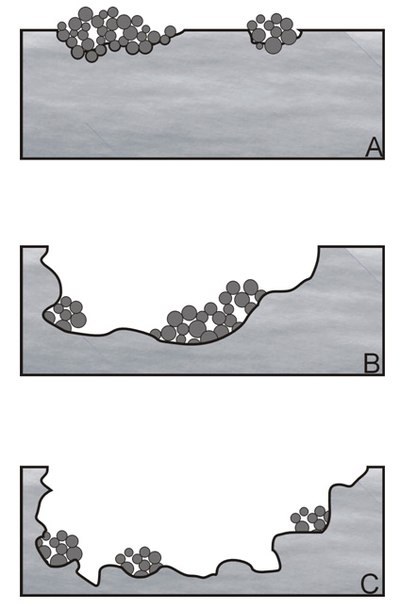Pitting (structural damage)
The pitting is one of the most frequently occurring type of lesion of cut stones, especially those of old historic buildings. Easily weatherable and acid-sensitive materials and building blocks, such as limestone or marble , are often affected by this.
The formation of pits or pitting can have various causes. The pitting can be traced back to two possible causes:
- Biogen induced pitting and
- Chemically / physically conditioned pitting
Biogenically induced pitting
'Pitting' is one of the most common biogenic damage to lime and marble building blocks. The pits are mainly noticeable due to their (especially microscopic) number, but are not superficially one of those types of damage that cause very severe damage. If the individual pits exceed a certain size and quantity, they are visible to the naked eye and initially lead to an aesthetic impairment, later, with increasing damage, also to a threat to the building fabric.
Damage pattern
Depending on the size of the individual pits, macropits and micropits can be differentiated. All those damages that are visible to the naked eye are called macropits and are differentiated from those that can only be seen under the microscope, the micropits. Stones damaged by 'pitting' have round to oval defects with concave cavities of varying depth. These range in their dimensions from microscopic orders of magnitude to individual 1.5 cm formations.
While the 'macropits' appear quite selective, the 'micropitting' is much more widespread.
Educational mechanism
Micropits can be traced back to the colonization of the rock surface by Dematiaceae and epi- and endolithic lichens . The damage to the stone by these lichens and fungi is caused by combined chemical-physical-mechanical weathering. The main cause of the damage and the formation of pits lies in the metabolic products of the microorganisms mentioned. The most important compounds to be mentioned here include carbon dioxide (CO 2 ), citric acid (C 6 H 8 O 7 ) and oxalic acid (C 2 H 2 O 4 ). When these compounds are dissolved in water , oxonium ions are released and the pH value is lowered . The release of these weathering-active metabolic products leads to chemical weathering of the marble in the direct vicinity of these organisms. The smooth and round walls, which are concentric around the lichen located in the center, speak in favor of etching or dissolving processes in the formation of the 'pits'.
However, the harmful organisms do not only occur on the surface of the stone. If the porosity of the stone allows, lichens can also be detected in deeper regions, below the surface of the stone. However, this is only possible if the marble offers sufficient space for colonization through a sufficiently large pore space. For example, the intergranular softening and microcracks can provide enough space for settlement.
A prerequisite for the successful mass colonization of a marble by fungi and lichens is a marble that is weakened in its strength and an adequate supply of water and light. The anthropogenically processed surfaces, e.g. B. of marble. Processing with tools destroys or weakens the grain structure (e.g. marble). These are ideal points of attack for the mycelium of lichens and fungi to penetrate. Individual colonies colonize the surface and continue to penetrate into pore spaces and intergranular spaces. Metabolic reactions and mechanical pressure of this biomass lead to an additional loosening of the binding of the affected calcite crystals . As the damage progresses, individual (calcite) crystals also loosen.
The 'macropits' emerge through successive growth directly from the microscopic forms of the pitting. Fungi that belong to the Dematiaceae group (yeast-like fungi) can almost exclusively be considered the active cause of damage for macropits. They form black, nodular micro-colonies.
Chemically / physically conditioned pitting
The purely chemical / physical pitting can be traced back to various types of corrosion processes. One possible example is pyrite inclusions in marble. The pyrite can undergo oxidation processes when it comes into contact with atmospheric oxygen and moisture , which in turn results in the formation of sulfuric acid as one of the oxidation products. The sulfuric acid is neutralized by the surrounding calcite, but leads to its dissolution through the neutralization reaction. Micro and macro pits around the former, later completely weathered, pyrite inclusion are the result.


